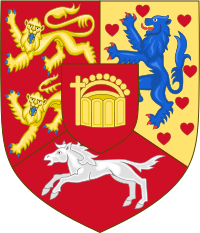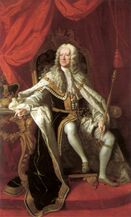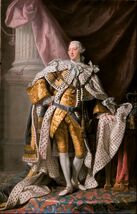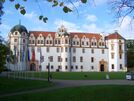بيت هانوڤر
| بيت هانوڤر | |
|---|---|
 درع بيت هانوڤر | |
| البيت الأم | بونيفيس → أوبرتنگي → إسته → ڤلف |
| البلد | |
| أصل الاسم | هانوڤر |
| تأسست | 1635 |
| المؤسس | جورج، دوق برونزويك-لونبورگ |
| الرأس الحالي | إرنست أوگست، أمير هانوڤر |
| الألقاب |
|
| الإطاحة |
|
بيت هانوڤر (ألمانية: Haus Hannover، إنگليزية: House of Hanover)، الذي يُعرف أفرادها باسم الهنوڤريين، هي أسرة ملكية أوروپية من أصل ألماني[1] حكمت هانوڤر، [[مملكة بريطانيا العظمى|بريطانيا العظمى]، أيرلندا في أوقات مختلفة أثناء القرن 17 حتى القرن 20. نشأت الأسرة عام 1635 كفرع أصغر من بيت برونزويك-لونبورگ، وتنامت مكانتها حتى أصبحت ناخبية عام 1692. أصبح جورج الأول أول ملك لهانوڤر في بريطانيا العظمى وأيرلندا في عام 1714. عند وفاة الملكة ڤيكتوريا عام 1901، انتقل عرش المملكة المتحدة إلى ابنها الأكبر إدوارد السابع، من بيت ساكسه-كوبورگ-وگوتا. خسر آخر أفراد الأسرة دوقية برونزويك عام 1918 عندما أصبحت ألمانيا جمهورية.
كان الاسم السابق للبيت هو بيت برونزويك-لونبورگ، خط هانوڤر.[2] انقرضت خط برونزويك-لونبورگ الأقدم، الذي حكم برونزويك-ڤولفنبوتل عام 1884. أصبح بيت هانوڤر الآن الفرع الوحيد الباقي من بيت ڤلف، وهو الفرع الرئيسي لبيت إسته. الرأس الحالي لبيت هانوڤر هو إرنست أوگست، أمير هانوڤر.
التاريخ
دوقات وناخبو برونزويك-لونبورگ
ملوك بريطانيا العظمى، أيرلندا، وهانوڤر
عام 1714 أصبح جورج لويس أول ملك بريطاني لبيت هانوڤر باسم جورج الأول.[3] ينتمي للأسرة ستة ملوك بريطانيين:
من مملكتي بريطانيا العظمى وأيرلندا (تغيرات عام 1801 إلى المملكة المتحدة لبريطانيا العظمى وأيرلندا):[note 1]
- جورج الأول (حكم 1714–1727) (گيورگ لودڤيگ = جورج لويس)
- جورج الثاني (حكم 1727–1760) (گيورگ أوگستس = جورج أوگستس)
- جورج الثالث (حكم 1760–1820)
- جورج الرابع (حكم 1820–1830)
- وليام الرابع (حكم 1830–1837)
- ڤيكتوريا (حكمت 1837–1901).
كما عمل جورج الأول وجورج الثاني وجورج الثالث كناخبين ودوقات لبرونزويك-لونبورگ، بشكل غير رسمي، ناخبي هانوڤر (راجع "الاتحاد الشخصي").
من 1814، عندما أصبحت هانوڤر مملكة، أصبح الملك البريطاني أيضاً ملك هانوڤر.
Upon the death of William IV in 1837, the personal union of the thrones of the United Kingdom and Hanover ended. Succession to the Hanoverian throne was regulated by semi-Salic law (agnatic-cognatic), which gave priority to all male lines before female lines, so that it passed not to Queen Victoria but to her uncle, the Duke of Cumberland.[3] In 1901, when Queen Victoria, the last British monarch provided by the House of Hanover, died, her son and heir Edward VII became the first British Monarch of the House of Saxe-Coburg and Gotha, Edward taking his family name from that of his father, Prince Albert of Saxe-Coburg-Gotha.[3]
ملوك هانوڤر بعد حل الاتحاد الشخصي
After the death of William IV in 1837, the following kings of Hanover continued the dynasty:
- Ernest Augustus, King of Hanover (r. 1837–1851)
- George V (r. 1851–1866, deposed)
The Kingdom of Hanover ended in 1866 when it was annexed by Kingdom of Prussia and the king of Hanover (and duke of Cumberland) was forced to go into exile in Austria. The 1866 rift between the houses of Hanover and Hohenzollern was settled by the 1913 marriage of Princess Viktoria Luise of Prussia to Ernest Augustus, Duke of Brunswick, the last king's grandson.
Prince-bishops of Osnabrück
At the end of the Thirty Years' War, the Peace of Westphalia (1648) awarded the Prince-Bishopric of Osnabrück alternately to a Catholic bishop and to a cadet branch of Brunswick-Lüneburg.[4] Since the treaty gave cadets priority over heirs and reigning princes, Osnabrück became a form of appanage (in alternation) of the House of Hanover.
- Ernest Augustus, Elector of Brunswick-Lüneburg (r. 1662–1698), fourth son of George, Duke of Brunswick-Lüneburg
- Ernest Augustus, Duke of York and Albany (r. 1715–1728), sixth son of Ernest Augustus, Elector of Brunswick-Lüneburg
- Prince Frederick, Duke of York and Albany (r. 1764–1802), second son of George III
Osnabrück was mediatized to Hanover in 1803.
دوقات برونزويك
المطالبون بالعرش
The later heads of the House of Hanover have been:
- George V (1866–1878)
- Ernest Augustus, Crown Prince of Hanover, 3rd Duke of Cumberland and Teviotdale (1878–1923)
- Ernest Augustus, Duke of Brunswick (1923–1953), son of the previous
- Ernest Augustus, Prince of Hanover (1953–1987)
- Ernest Augustus, Prince of Hanover (1987–present)
قائمة الأفراد
النسب الأبوي
- Oberto I, 912–975
- Oberto Obizzo, 940–1017
- Albert Azzo I, Margrave of Milan, 970–1029
- Albert Azzo II, Margrave of Milan, died 997 or 1009
- Welf I, Duke of Bavaria, 1037–1101
- Henry IX, Duke of Bavaria, 1074–1126
- Henry X, Duke of Bavaria, 1108–1139
- Henry the Lion, 1129–1195
- William of Winchester, Lord of Lunenburg, 1184–1213
- Otto I, Duke of Brunswick-Lüneburg, 1204–1252
- Albert I, Duke of Brunswick-Lüneburg, 1236–1279
- Albert II, Duke of Brunswick-Lüneburg, 1268–1318
- Magnus the Pious, Duke of Brunswick-Lüneburg, 1304–1369
- Magnus II, Duke of Brunswick-Lüneburg, 1328–1373
- Bernard I, Duke of Brunswick-Lüneburg, 1362–1434
- Frederick II, Duke of Brunswick-Lüneburg, 1408–1478
- Otto V, Duke of Brunswick-Lüneburg, 1439–1471
- Heinrich, Duke of Brunswick-Lüneburg, 1468–1532
- Ernest I, Duke of Brunswick-Lüneburg, 1497–1546
- William, Duke of Brunswick-Lüneburg, 1535–1592
- George, Duke of Brunswick-Lüneburg, 1582–1641
- Ernest Augustus, Elector of Hanover, 1629–1698
- George I of Great Britain, 1660–1727
- George II of Great Britain, 1683–1760
- Frederick, Prince of Wales, 1707–1751
- George III of the United Kingdom, 1738–1820
- Ernest Augustus, King of Hanover, 1771–1851
- George V of Hanover, 1819–1878
- Ernest Augustus, Crown Prince of Hanover, 1845–1923
- Ernest Augustus, Duke of Brunswick, 1887–1953
- Ernest Augustus, Prince of Hanover, 1914–1987
- Ernst August, Prince of Hanover, b. 1954
- Prince Ernest Augustus of Hanover, b. 1983
قالب:House of Hanover family tree
الذكرى
Many towns and provinces across the British Empire were named after the ruling House of Hanover and its members, among them the U.S. state of Georgia, U.S. towns Hanover, Massachusetts, Hanover, New Hampshire, Hanover, Pennsylvania, Hanover Township, Jo Daviess County, Illinois, counties Hanover County, Virginia, Caroline County, Virginia, Brunswick County, Virginia, New Hanover County, North Carolina, Brunswick County, North Carolina, King George County, Virginia, places named Georgia in New Jersey (e.g. New Brunswick, NJ), Vermont, Arkansas and South Dakota, seven towns in the U.S. and Canada named after Queen Charlotte, furthermore the Canadian province of New Brunswick and towns Hanover, Ontario, Guelph, Ontario, and Victoria, British Columbia, in South Africa the town Hanover, Northern Cape, in Australia the state Victoria (Australia) and the city Adelaide, in the UK six and in the US thirteen towns named Brunswick, furthermore one each in Australia and New Zealand, and worldwide more than fifty towns named Victoria. There are also numerous streets and squares, such as Hanover Square, Westminster, Hanover Square (Manhattan), Hanover Square, Syracuse or Queen Street, Brisbane with its intersections named after members of the House.
Georgian architecture gives distinction to the architectural styles current between 1714 and 1830 in most English-speaking countries.
انظر أيضاً
- Family tree of the Hanoverian British monarchs
- Georgian era for kings George I, II, III, IV
- History of Hanover
الهوامش
- ^ عام 1801، اندمجت المملكتان البريطانية والأيرلندية، وشكلتا المملكة المتحدة لبريطانيا العظمى وأيرلندا.
المصادر
- ^ "house of Hanover | Facts, History, & Monarchs | Britannica". www.britannica.com (in الإنجليزية). Retrieved 2022-02-09.
- ^ "Royal Arms of Britain". Heraldica. Retrieved 10 May 2016.
The House of Brunswick Luneburg being one of the most illustrious and most ancient in Europe, the Hanoverian branch having filled for more than a century one of the most distinguished thrones, its possessions being among the most considerable in Germany;
- ^ أ ب ت Picknett, Lynn; Prince, Clive; Prior, Stephen; Brydon, Robert (2002). War of the Windsors: A Century of Unconstitutional Monarchy. Mainstream Publishing. ISBN 1-84018-631-3..
- ^ Duggan, J. N. (2011). Sophia of Hanover: From Winter Princess to Heiress of Great Britain, 1630–1714. London: Peter Owen Publishers. ISBN 9780720614237.
According to the Peace of Westphalia, the See of Osnabrück was to be held alternately by a Catholic and a Protestant incumbent; the Protestant bishop was to be a younger son of the Brunswick-Lüneburg family.
قراءات إضافية
- Black, Jeremy (2003). "Georges I & II: Limited monarchs". History Today. 53 (2): 11+.
- Black, Jeremy (2004). The Hanoverians: The History of a Dynasty.
- Fraser, Flora. (2005). Princesses: The Six Daughters of George III. Knopf.
- Plumb, J. H. (1974). The First Four Georges (Revised ed.). Hamlyn.
- Redman, Alvin (1960). The House of Hanover. Coward-McCann.
- Robertson, Charles (1911). England under the Hanoverians.
- Schweizer, Karl W.; Black, Jeremy (1989). Politics and the Press in Hanoverian Britain. E. Mellon Press.
- Simms, Brendan; Riotte, Torsten, eds. (2009). The Hanoverian Dimension in British History, 1714–1837. Cambridge University Press. doi:10.1017/CBO9780511496936. ISBN 9780511496936.
- Van der Kiste, John (1992). George III's Children. Sutton Publishing.
تأريخ
- Bultmann, William A. "Early Hanoverian England (1714–1760): Some Recent Writings," in Elizabeth Chapin Furber, ed. Changing views on British history: essays on historical writing since 1939 (Harvard University Press, 1966), pp 181–205
- O’Gorman, Frank (1986). "The Recent Historiography of the Hanoverian Regime". Historical Journal. 29 (4): 1005–1020. doi:10.1017/S0018246X00019178.
- Snyder, Henry L. "Early Georgian England," in Richard Schlatter, ed., Recent Views on British History: Essays on Historical Writing since 1966 (Rutgers UP, 1984), pp. 167–196, historiography
وصلات خارجية
- (in ألمانية) Official website of the House of Welf
- Succession laws in the House of Welf
- British German Royal Heritage Route 2014
- House of Hanover Archive.org
- British Hanoverian Family tree
بيت هانوڤر فرع أصغر من بيت ڤلف
| ||
| لقب حديث |
Ruling house of the Duchy of Brunswick-Lüneburg 1235–1692 |
Duchy raised to Electorate by Emperor Leopold I for aid given in the Nine Years' War |
| لقب حديث Duchy raised to Electorate
|
Ruling house of the Electorate of Hanover 1692–1803 |
Electorate abolished Occupied by France in the Napoleonic Wars |
| سبقه House of Stuart |
Ruling house of the Kingdom of Great Britain 1714–1800 |
Kingdoms merged by Acts of Union 1800 |
| Ruling house of the Kingdom of Ireland 1714–1800 | ||
| لقب حديث Union of Great Britain and Ireland
|
Ruling house of the United Kingdom 1801–1901 |
تبعه House of Saxe-Coburg and Gotha |
| لقب حديث Electorate raised to Kingdom
at the Congress of Vienna |
Ruling house of the Kingdom of Hanover 1814–1866 |
Kingdom abolished Annexed by Prussia in the Austro-Prussian War |
| سبقه House of Brunswick-Wolfenbüttel-Bevern |
Ruling house of the Duchy of Brunswick 1913–1918 |
Duchy abolished German Revolution after defeat in World War I |
قالب:Royal houses of Germany قالب:Royal houses of Britain and Ireland قالب:European royal families
- Short description is different from Wikidata
- Articles with hatnote templates targeting a nonexistent page
- Missing redirects
- Articles containing ألمانية-language text
- Pages using Lang-xx templates
- Articles containing إنگليزية-language text
- Pages using multiple image with auto scaled images
- مقالات ناطقة
- Articles with ألمانية-language sources (de)
- بيت هانوڤر
- العلاقات الألمانية البريطانية
- عائلات ملكية أوروپية
- تاريخ هانوڤر (منطقة)
- مقاطعة نيو هانوڤر، كارولاينا الشمالية




















